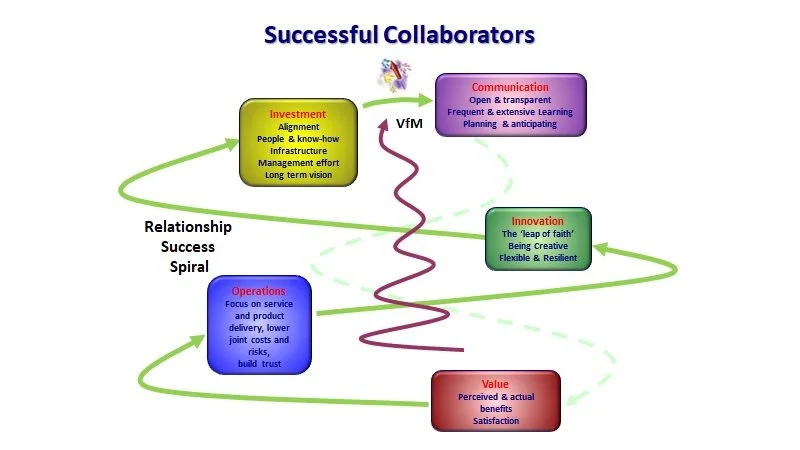The Golden Geese
Thirty-six point one percent of relationships we have studied are successful collaborators. These are often mature relationships that have become well established over time. In this grouping there are also new companies based on a novel product or service or, established partners who have developed an innovative offering. The overall relationship satisfaction is exceptionally high.
“I have a good working relationship with everyone I deal with in their organisation. I even call the MD himself on his cell phone when I have a problem and he will deal with it.” (Customer)
“We run a very trusting system, we tell them our 20 week production forecast so they know we are not selling elsewhere on the open market.“ (Supplier)
Their situation looks like this:
These relationships are likely to contain high levels of interdependence, co-operating, co-ordinating, collaborating (C3) behaviour. Moreover, information sharing and innovation will be strong. The result is efficient, effective supply chains focused on customer requirements. Well above average returns may be expected i.e. 1+1=4,5,6.
Their self-assessment of the relationship indicates very few factors could be improved and there is complete collaborative harmony. The level of trust is very high and both sides have the utmost belief in the abilities and competencies of their partner as well as their intention to operate in the best interests of the relationship. They are committed to common goals, believe in the commercial benefits of the alliance and, continue to invest in infrastructure, training, personnel resources and IT linkages. Levels of co-ordination to organise and plan for co-operative activity would also be high with much energy being devoted to driving collaborative initiatives.
However, insidious dangers might creep in that could lead to decline:
· Becoming inward looking and failing to notice the world has moved on
· Within a cosy relationship there is less likelihood of critical performance review
· Becoming too reliant on each other i.e. locked in to a single solution
· Bolstering the status quo to the exclusion of innovation
· Becoming process bound, being unwilling to step outside the box and losing flexibility
· Lack of constructive conflict and a willingness to defend new ideas thus stifling innovation
In summary ‘golden geese’ may be very effective alliances but there is a danger of them becoming complacent. They are likely to be still ‘riding their original success wave’ but at some point, if they fail to continuously improve the relationship, they can begin sending out conflicting messages to the market and themselves. This is when they lose their edge, become inflexible and are vulnerable to external changes.
“We wonder at times if the local UK strategy aligns with their corporate world-wide vision.” (Customer)
The secret of maintaining the ‘golden goose’ relationship is the partners must recognise their high-performance capability to work together, to test and trial new approaches in the knowledge that their inherent strength will typically sustain the momentum.
This will be supported by a target operating model such as the one described in practical, step-by-step fashion in our book Implementing and Managing Collaborative Relationships.

